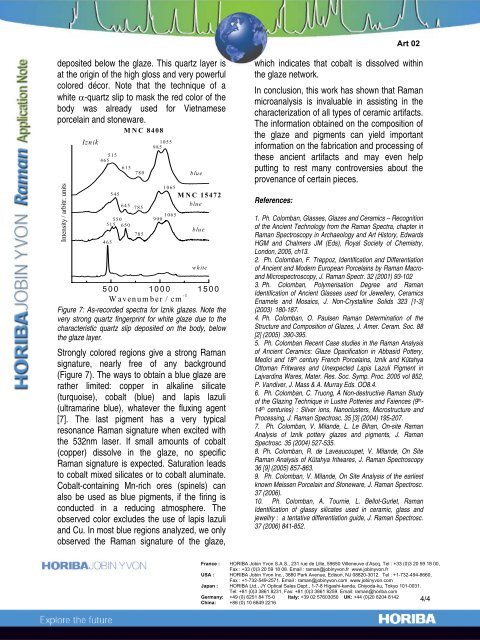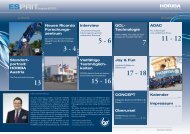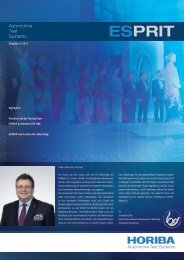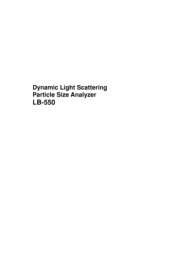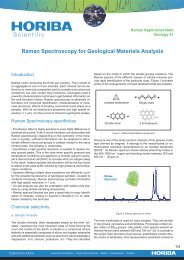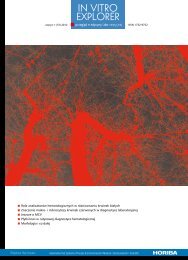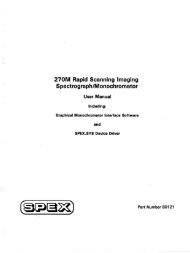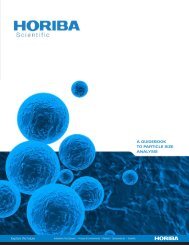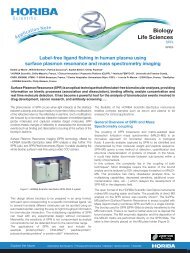Raman Spectroscopy - Art Application Note - Horiba
Raman Spectroscopy - Art Application Note - Horiba
Raman Spectroscopy - Art Application Note - Horiba
Create successful ePaper yourself
Turn your PDF publications into a flip-book with our unique Google optimized e-Paper software.
deposited below the glaze. This quartz layer is<br />
at the origin of the high gloss and very powerful<br />
colored décor. <strong>Note</strong> that the technique of a<br />
white α-quartz slip to mask the red color of the<br />
body was already used for Vietnamese<br />
porcelain and stoneware.<br />
Intensity / arbitr. units<br />
Iznik<br />
515<br />
465<br />
465<br />
545<br />
550<br />
515 650<br />
MNC 8408<br />
615<br />
645<br />
780<br />
785<br />
785<br />
1055<br />
985<br />
1065<br />
1065<br />
990<br />
blue<br />
MNC 15472<br />
blue<br />
blue<br />
white<br />
500 1000 1500<br />
Wavenumber / cm -1<br />
Figure 7: As-recorded spectra for Iznik glazes. <strong>Note</strong> the<br />
very strong quartz fingerprint for white glaze due to the<br />
characteristic quartz slip deposited on the body, below<br />
the glaze layer.<br />
Strongly colored regions give a strong <strong>Raman</strong><br />
signature, nearly free of any background<br />
(Figure 7). The ways to obtain a blue glaze are<br />
rather limited: copper in alkaline silicate<br />
(turquoise), cobalt (blue) and lapis lazuli<br />
(ultramarine blue), whatever the fluxing agent<br />
[7]. The last pigment has a very typical<br />
resonance <strong>Raman</strong> signature when excited with<br />
the 532nm laser. If small amounts of cobalt<br />
(copper) dissolve in the glaze, no specific<br />
<strong>Raman</strong> signature is expected. Saturation leads<br />
to cobalt mixed silicates or to cobalt aluminate.<br />
Cobalt-containing Mn-rich ores (spinels) can<br />
also be used as blue pigments, if the firing is<br />
conducted in a reducing atmosphere. The<br />
observed color excludes the use of lapis lazuli<br />
and Cu. In most blue regions analyzed, we only<br />
observed the <strong>Raman</strong> signature of the glaze,<br />
(All HORIBA Jobin Yvon companies were formerly known as Jobin Yvon)<br />
<strong>Art</strong> 02<br />
which indicates that cobalt is dissolved within<br />
the glaze network.<br />
In conclusion, this work has shown that <strong>Raman</strong><br />
microanalysis is invaluable in assisting in the<br />
characterization of all types of ceramic artifacts.<br />
The information obtained on the composition of<br />
the glaze and pigments can yield important<br />
information on the fabrication and processing of<br />
these ancient artifacts and may even help<br />
putting to rest many controversies about the<br />
provenance of certain pieces.<br />
References:<br />
1. Ph. Colomban, Glasses, Glazes and Ceramics – Recognition<br />
of the Ancient Technology from the <strong>Raman</strong> Spectra, chapter in<br />
<strong>Raman</strong> <strong>Spectroscopy</strong> in Archaeology and <strong>Art</strong> History, Edwards<br />
HGM and Chalmers JM (Eds), Royal Society of Chemistry,<br />
London, 2005, ch13.<br />
2. Ph. Colomban, F. Treppoz, Identification and Differentiation<br />
of Ancient and Modern European Porcelains by <strong>Raman</strong> Macro-<br />
and Microspectroscopy, J. <strong>Raman</strong> Spectr. 32 (2001) 93-102<br />
3. Ph. Colomban, Polymerisation Degree and <strong>Raman</strong><br />
Identification of Ancient Glasses used for Jewellery, Ceramics<br />
Enamels and Mosaics, J. Non-Crystalline Solids 323 [1-3]<br />
(2003) 180-187.<br />
4. Ph. Colomban, O. Paulsen <strong>Raman</strong> Determination of the<br />
Structure and Composition of Glazes, J. Amer. Ceram. Soc. 88<br />
[2] (2005) 390-395.<br />
5. Ph. Colomban Recent Case studies in the <strong>Raman</strong> Analysis<br />
of Ancient Ceramics: Glaze Opacification in Abbasid Pottery,<br />
Medici and 18 th century French Porcelains, Iznik and Kütahya<br />
Ottoman Fritwares and Unexpected Lapis Lazuli Pigment in<br />
Lajvardina Wares, Mater. Res. Soc. Symp. Proc. 2005 vol 852,<br />
P. Vandiver, J. Mass & A. Murray Eds. OO8.4.<br />
6. Ph. Colomban, C. Truong, A Non-destructive <strong>Raman</strong> Study<br />
of the Glazing Technique in Lustre Potteries and Faiences (9 th -<br />
14 th centuries) : Silver ions, Nanoclusters, Microstructure and<br />
Processing, J. <strong>Raman</strong> Spectrosc. 35 [3] (2004) 195-207.<br />
7. Ph. Colomban, V. Milande, L. Le Bihan, On-site <strong>Raman</strong><br />
Analysis of Iznik pottery glazes and pigments, J. <strong>Raman</strong><br />
Spectrosc. 35 (2004) 527-535.<br />
8. Ph. Colomban, R. de Laveaucoupet, V. Milande, On Site<br />
<strong>Raman</strong> Analysis of Kütahya fritwares, J. <strong>Raman</strong> <strong>Spectroscopy</strong><br />
36 [9] (2005) 857-863.<br />
9. Ph. Colomban, V. Milande, On Site Analysis of the earliest<br />
known Meissen Porcelain and Stoneware, J. <strong>Raman</strong> Spectrosc.<br />
37 (2006).<br />
10. Ph. Colomban, A. Tournie, L. Bellot-Gurlet, <strong>Raman</strong><br />
Identification of glassy silicates used in ceramic, glass and<br />
jewellry : a tentative differentiation guide, J. <strong>Raman</strong> Spectrosc.<br />
37 (2006) 841-852.<br />
France : HORIBA Jobin Yvon S.A.S., 231 rue de Lille, 59650 Villeneuve d’Ascq. Tel : +33 (0)3 20 59 18 00,<br />
Fax : +33 (0)3 20 59 18 08. Email : raman@jobinyvon.fr www.jobinyvon.fr<br />
USA : HORIBA Jobin Yvon Inc., 3880 Park Avenue, Edison, NJ 08820-3012. Tel : +1-732-494-8660,<br />
Fax : +1-732-549-2571. Email : raman@jobinyvon.com www.jobinyvon.com<br />
Japan : HORIBA Ltd., JY Optical Sales Dept., 1-7-8 Higashi-kanda, Chiyoda-ku, Tokyo 101-0031.<br />
Tel: +81 (0)3 3861 8231, Fax: +81 (0)3 3861 8259. Email: raman@horiba.com<br />
Germany: +49 (0) 6251 84 75-0<br />
China: +86 (0) 10 6849 2216<br />
Italy: +39 02 57603050 UK: +44 (0)20 8204 8142 4/4


